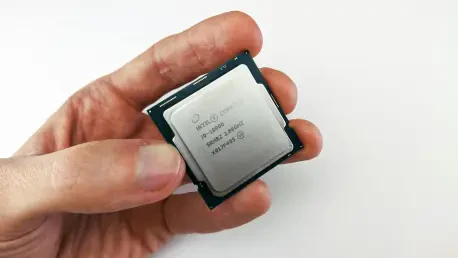In a landscape where laptop performance and efficiency are constantly being pushed to new heights, Intel has unveiled a groundbreaking development with the Panther Lake architecture, a next-generation processor design tailored for consumer laptops, potentially under the Core Ultra (X) 300 branding, though official confirmation is still pending. This architecture, revealed alongside the datacenter-focused Clearwater Forest, marks a significant stride forward for Intel in the competitive world of laptop silicon. It’s not just another incremental update; Panther Lake promises to redefine user experiences across a spectrum of devices, from sleek ultraportables to powerful gaming machines, by delivering cutting-edge advancements in power, graphics, and connectivity.
The essence of Panther Lake lies in its ability to balance raw computational strength with energy efficiency, addressing a critical demand in modern computing where battery life is as vital as speed. Intel has infused this architecture with innovations spanning CPU, GPU, AI processing, and networking capabilities, showcasing a clear intent to cater to diverse user needs. A notable focus on AI integration highlights the company’s vision for smarter, adaptive technology that enhances everything from productivity to entertainment. With a hybrid, tile-based design continuing from previous generations, Panther Lake offers modularity and scalability, ensuring it can power a wide range of laptop categories with optimized performance and cost efficiency. This unveiling has sparked excitement in the tech community, positioning Intel as a formidable player ready to challenge industry standards with a comprehensive suite of upgrades.
Core Innovations and Performance Boosts
Revamped CPU Designs: Cougar Cove and Darkmont
Intel’s Panther Lake architecture introduces a fresh approach to CPU design with the debut of Cougar Cove Performance cores (P-cores) and Darkmont Efficiency cores (E-cores), replacing the older Lion Cove and Skymont/Crestmont cores seen in Arrow Lake and Lunar Lake processors. These new cores deliver a remarkable performance uplift, with Intel claiming over a 10% improvement in single-threaded tasks at comparable power levels. Even more striking is the power efficiency, where Panther Lake consumes up to 40% less energy to match the single-threaded performance of its predecessors and 30% less to reach Arrow Lake’s peak multi-threaded output. This leap in efficiency is poised to significantly extend battery life in laptops, a crucial factor for users on the go who rely on their devices for extended periods without access to power outlets.
Beyond raw numbers, the design philosophy behind these cores reflects a return to shared architectures between E-cores and Low Power Efficiency (LPE) cores, echoing the original Meteor Lake approach. This strategic alignment allows for better workload distribution across different core types, ensuring that power-hungry tasks don’t unnecessarily drain resources. The advancements aren’t just about speed but also about smarter energy management, which could translate into cooler, quieter laptops even under heavy loads. While exact figures for maximum power performance gains remain under wraps, estimates suggest a 10-20% improvement range, positioning Panther Lake as a formidable contender in the processor market where every percentage point of efficiency can sway consumer choice.
Flexible Configurations and Smart Task Management
Panther Lake offers a variety of core configurations to suit different laptop classes, ranging from an 8-core model featuring 4 P-cores and 4 LPE-cores to two 16-core variants, both equipped with 4 P-cores, 8 E-cores, and 4 LPE-cores, though differing in GPU and memory setups. This flexibility ensures that manufacturers can tailor devices to specific user segments, whether for lightweight premium notebooks or robust gaming systems. Such diversity in configuration underlines Intel’s commitment to scalability, allowing the architecture to address a broad spectrum of performance needs without compromising on design efficiency or manufacturing costs, a critical aspect in a highly competitive industry.
Complementing these configurations is the enhanced Thread Director technology, a hardware-based scheduler that intelligently allocates workloads across core clusters for optimal performance. For instance, low-demand applications like video conferencing tools are primarily handled by LPE-cores to save power, while intensive tasks such as rendering or benchmarking engage all core types for maximum output. Gaming workloads strategically bypass LPE-cores to avoid bottlenecks, ensuring smooth frame rates. Additionally, the Intel Intelligent Experience Optimizer automatically tweaks power profiles based on system load, offering seamless performance adjustments that benefit users who may not have the technical know-how to manually optimize their devices, thus broadening the accessibility of high-end computing.
Graphics and Gaming Breakthroughs
Xe3 GPU: Redefining Integrated Graphics
The introduction of the Xe3 GPU architecture in Panther Lake marks a pivotal moment for integrated graphics, particularly in the realm of gaming laptops, with Intel touting a 50% performance increase over Lunar Lake’s Arc 140V graphics and a 40% better performance-per-watt ratio compared to Arrow Lake-H’s original Xe graphics. This upgrade isn’t merely numerical; it encompasses enhancements in cache, ray tracing capabilities, power efficiency, and codec support, making Panther Lake a serious option for users who prefer not to invest in discrete GPUs. Available in two variants—a 4 Xe3-core version for lighter configurations and a full 12 Xe3-core version for high-end setups—this GPU aims to deliver desktop-like graphics performance directly from the processor.
What sets the Xe3 apart is its focus on bridging the gap between integrated and dedicated graphics, a domain where Intel has historically faced challenges. The improved efficiency means laptops can handle graphically intensive tasks without overheating or rapidly draining the battery, a common pain point for mobile gamers and content creators. While driver optimizations remain an ongoing process, the architectural advancements suggest a strong foundation for future software updates to unlock even greater potential. This positions Panther Lake as a compelling choice for manufacturers looking to build powerful yet compact systems that don’t compromise on visual quality or energy demands, potentially reshaping market expectations for what integrated graphics can achieve.
Gaming Features: XeSS-MFG and Performance Tools
For gamers, Panther Lake brings innovative features like XeSS-MFG, a multi-frame generation technology that can generate up to three intermediate frames, effectively quadrupling frame rates using in-game motion and depth data. This capability, adjustable through Intel Graphics Software, mirrors advanced techniques seen in competing technologies and aims to provide smoother gameplay even on demanding titles. To counter potential input lag—a common drawback of frame generation—Intel has updated its PresentMon tool to display both effective and native frame rates, alongside frame type differentiation and an Animation Error metric, offering users deeper insights into performance dynamics for fine-tuning their gaming experience.
Another noteworthy addition is Precompiled Shader Distribution, which tackles the frustrating delays of game launch times caused by shader compilation. By offloading this process to cloud servers, users can download precompiled shader packages tailored to their specific systems, minimizing wait times even after driver updates. Additionally, Intelligent Bias Control v3 optimizes power distribution during gaming by shifting background tasks to low-power E-cores, freeing up resources for the GPU to maximize frame rates. These features collectively demonstrate Intel’s intent to cater to the gaming community with practical, performance-enhancing solutions that address real-world pain points, potentially elevating the appeal of Panther Lake-equipped laptops among enthusiasts and casual players alike.
AI and Imaging Capabilities
NPU 5: Efficiency in AI Workloads
Panther Lake’s fifth-generation Neural Processing Unit, dubbed NPU 5, shifts the focus from sheer computational power to efficiency, delivering 50 TOPS for AI tasks while occupying less die area compared to its predecessor in Lunar Lake, which offered 48 TOPS. This redesign is significant, as it frees up valuable chip space for other functions, a critical consideration given the high area cost of NPUs and their currently limited software ecosystem. Supporting FP8 compute, NPU 5 achieves a 50% boost in performance-per-watt over the older FP16 standard, as evidenced in tests with tools like Stable Diffusion, highlighting its capability to handle AI models faster and more efficiently.
When combined with contributions from the CPU (10 TOPS) and GPU (120 TOPS), Panther Lake reaches a total of 180 TOPS for AI workloads, a substantial jump from Lunar Lake’s 120 TOPS, driven largely by the enhanced GPU. This comprehensive AI power positions the architecture to support a growing array of machine learning applications, from real-time language processing to image enhancement, directly on the device. As software support for NPUs expands, this efficiency-focused design could become a key differentiator, enabling laptops to perform complex AI tasks without relying heavily on cloud resources, thus improving speed and privacy for users engaged in creative or productivity-driven workflows.
IPU 7.5: Superior Imaging for Virtual Communication
The Image Processing Unit in Panther Lake advances to IPU 7.5, a subtle but impactful upgrade from Lunar Lake’s IPU 7, with a clear emphasis on enhancing webcam and imaging performance for teleconferencing, a feature that has become indispensable in the era of remote work. Among the new capabilities is Staggered HDR blending, which merges overexposed and underexposed images to produce detailed 4K output while conserving power, ensuring users appear clear and professional even in challenging lighting conditions. This technology addresses a common frustration in virtual meetings, where poor image quality can hinder effective communication.
Further elevating the imaging experience are features like AI-based noise reduction, which leverages neural networks from the NPU or GPU to refine image clarity, and Advanced Tone Mapping, which adjusts colors locally based on content for superior visual fidelity. These enhancements aim to deliver near-professional-grade imaging straight from laptop webcams, reducing the need for external hardware or software tweaks. As hybrid work environments continue to dominate, such upgrades cater directly to the demand for seamless, high-quality virtual interactions, positioning Panther Lake as a forward-thinking solution for professionals who rely on video calls as a core part of their daily operations, ensuring they can present themselves with confidence and clarity.
Connectivity and Network Enhancements
Next-Gen Standards: Wi-Fi 7 R2 and Bluetooth 6.0
Panther Lake integrates the latest connectivity standards directly into its Platform Controller Tile, eliminating the need for discrete modules and freeing up motherboard space for components like larger batteries, a practical design choice for laptop manufacturers. Wi-Fi 7 R2 offers a staggering maximum throughput of 11Gbps, a significant leap from the 5Gbps of previous CNVio2 interfaces, through the updated CNVio3 interface. Accompanying features include multi-link reconfiguration for power efficiency, restricted target wake time to prevent connection dropouts, enhanced single-link multi-radio switching, and peer-to-peer channel coordination for efficient local file transfers, all of which ensure robust networking performance for modern demands.
Bluetooth 6.0 further enhances connectivity with dual antennas, nearly doubling the range and improving stability with a signal strength boost of +3 to +5dB. Additional functionalities include Auracast for public audio broadcasting via Bluetooth LE Audio, and Channel Sounding for precise range measurement, which can be leveraged in security applications. These advancements cater to a wide range of use cases, from personal entertainment to professional settings, ensuring that users experience fewer interruptions and greater flexibility in how they connect their devices. As reliance on wireless technology grows, Panther Lake’s connectivity upgrades provide a future-proof foundation that keeps pace with evolving user expectations for speed and reliability.
Optimizing Networks with Connectivity Performance Suite 5.0
Intel’s Connectivity Performance Suite 5.0 introduces a suite of tools designed to maximize network efficiency, incorporating advanced Bluetooth monitoring and bidirectional Quality of Service (QoS) management to ensure smooth operation across diverse applications. A standout feature is AI-aware QoS, which prioritizes network traffic for AI-driven platforms, ensuring seamless experiences on tools like ChatGPT that require consistent bandwidth. This intelligent traffic management is crucial in environments where multiple applications compete for network resources, preventing lag or interruptions during critical tasks.
Beyond prioritization, the suite enhances overall connectivity by adapting to real-time network conditions, optimizing performance for both wired and wireless connections. This adaptability is particularly beneficial for users who juggle video streaming, large file transfers, and online collaboration simultaneously, as it minimizes bottlenecks that could degrade the experience. By embedding such sophisticated network management directly into the architecture, Panther Lake demonstrates a commitment to addressing the connectivity challenges of modern computing, ensuring that laptops equipped with this technology can handle the increasing demands of data-intensive workflows and entertainment without compromising on speed or stability.
Reflecting on Panther Lake’s Impact
Looking back, the introduction of Panther Lake proved to be a defining moment for Intel, showcasing a bold vision for the future of laptop processors through a harmonious blend of performance, efficiency, and innovation. The architecture tackled longstanding challenges in power consumption and graphics capability, while embedding AI and connectivity features that aligned perfectly with the evolving needs of users across casual, professional, and gaming domains. Each component upgrade, from the efficient CPU cores to the robust Xe3 GPU, reflected a meticulous effort to push technological boundaries while maintaining practical applicability in real-world scenarios.
As the industry moves forward, the focus should shift to how manufacturers leverage Panther Lake’s modular design to craft devices that truly cater to niche markets, whether by emphasizing battery life for ultraportables or maximizing graphics for gaming rigs. Software developers also have a role to play in fully harnessing the AI and imaging potential of NPU 5 and IPU 7.5 through optimized applications. For users, staying informed about driver updates and compatibility will be key to unlocking the full spectrum of benefits this architecture offers. Ultimately, Panther Lake laid a strong foundation for Intel to build upon, setting a high bar for competitors and promising exciting advancements in laptop technology for years to come.









